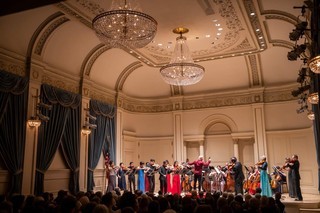|
Back
The Mysteries of Death and Transfiguration New York
Carnegie Hall, Weill Recital Hall
03/06/2023 -
Richard Strauss: Metamorphosen
Johannes Brahms: Piano Quintet in F Minor, Opus 34
Angela Wee, Katherine T. Fong (violins), Tai First (Viola), Julia Bruskin (Cello)
Met Orchestra Chamber Ensemble, Yannick Nézet‑Séguin (Piano, Conductor)

Y. Nézet‑Séguin, Met Chamber Ensemble (© Chris Lee)
“The most terrible period of human history is at an end, the twelve year reign of bestiality, ignorance and anti-culture under the greatest criminals, during which Germany’s 2,000 years of cultural evolution met its doom.”
Richard Strauss, 1945, two days after finishing Metamorphosen
“A landscape torn by mists and clouds, in which I can see ruins of old churches as well as Greek temples. That is Brahms.”
Edvard Grieg
Yannick Nézet‑Séguin served double‑duty last night–no, make that triple‑duty–in a memorable duo of orchestral and chamber music.
First, the Metropolitan Opera Music Director led the strings of the Met Orchestra Chamber Ensemble through their paces for a work which could be a nightmare for less experienced leaders. Next, Mr. Nézet‑Séguin was pianist in the mighty Brahms Piano Quintet. In that case, you can’t take the conducting out of the conductor, and Nézet‑Séguin, with head, eyes, smiles and sometimes arms, directed them.
That “nightmare” opening work was earned since Richard Strauss didn’t ask for a string orchestra: he wanted 23 separate strings. Not that they played different notes than their colleagues. Yet within this strange work, they all had a different job, different amount of energy. All made even more difficult, since the scored no key sign.
On to that word “strange”, an explanation.” Not a single major work by any major composer is without its chimerical and unknowable core. A philosophical mystery rarely known to the composers themselves. Thus the subconscious explanation for conductors and soloists. Each attempting to come close to that cryptical core.
The exception might be Richard Strauss, who wore his heart–and his art–on his sleeve. Whether depicting a windmill or a tablespoon or a glacier storm, or a mélange of dramatic characters, Strauss aimed for physical beauty incarnate. But that mystery behind the notes? No, the notes themselves sufficed.
That was until 1945, five years before his death. Metamorphosen had no explanation from the composer, only a few clues. He might have been depicting the fall of Germany (see quote above), or his own metamorphosis of Beethoven’s Eroica, or his own upcoming death and transfiguration.
At any rate Metamorphosen is so completely distant from his other works, that any conductor may be stumped to find a meaning. Mr. Nézet‑Séguin didn’t have to look for the core. The structure of slow‑fast‑slow was evident enough, the quotes from Beethoven were obvious. And it was his job to give the balance of separate sections.
Dividing the strings to different parts of the stage, albeit keeping the First Chair important soloists to the front, he led a non‑mawkish straightforward, energetic reading. That balance was essential, and Mr. Nézet‑Séguin managed, with his own passionate conducting to bring the Eroica themes, that ever‑present canonic minor‑key motif, and the equally ever‑present legato together for an inexorable and even relentless performance. Helped, of course, by the Met’s strings.
One must again give honors to the late James Levine, who turned that commonplace accompany band to a state of loving perfection.
Also, special honors to Yannick Nézet‑Séguin. Wearing a chartreuse polo‑shirt, his usual smile, one could sense the rapport he has with his musicians. Within the confines of Weill Concert Hall, one can feel almost an informality, and certainly a resonance among not leader and followers, but a troupe of artists together.
This was shown literally in the following Brahms Piano Quintet. So rightly popular is that massive work that no description is needed. Only needed are five experienced players, and the Met Chamber Ensemble had these.
I’ve heard the opening with more rustic feeling, but pianist Yannick Nézet‑Séguin conducted to ensure a pointed start. That, though, was the prelude to a more wondrous lilt. The variations of the second movement were given Brahms’ keynote of autumnal joy, and Mr. Nézet‑Séguin’s return to the original theme was almost heartbreaking.
The scherzo verged on the sinister, changed to a muscular lyrical trio. It was most powerful–but not as powerful as that massive finale. The “mystery” was the whispering slow opening, and this pounced into not the usual Gypsy dance, but a simple childish theme from the cello which all the players transformed into a thesaurus of emotions, ending with a flaming coda.
For both the Strauss and the Brahms, the audience requested, no, demanded five or six curtain calls. Within the luscious surroundings of the most beautiful concert hall in New York–see Chris Lee’s photo above–nothing could be more deserving.
Harry Rolnick
|